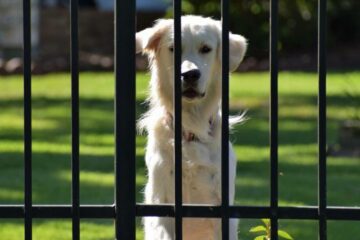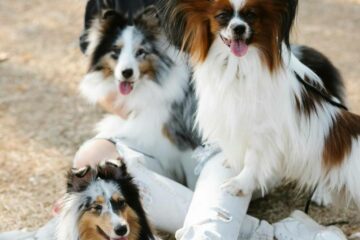Can Dogs Eat Flies? (+Stop Chasing and Barking!)
Can dogs eat flies? Will they get sick, or is it okay? In this article, we’ll answer all you need to know about those questions as well as teaching you the commands you need to prevent the behavior. And if you already have a dog eating flies or your dog ate fly bait, we’ll help you there too.
Once we’ve covered those things, we’ll move on and give you all the information you’ll need about your dog chasing flies, and what you can do about this. We’ll then finish up with something important to anyone wanting a quiet household: how to stop your dog barking at flies. Keep reading for all this and more!
Can Dogs Eat Flies?

Dogs can eat flies they catch occasionally without any immediate harm, but it’s not something to encourage. Flies carry a multitude of diseases and parasites that can potentially be harmful to your dog. In addition, dogs may also ingest harmful substances while chasing and eating flies.
Can My Dog Eat Flies?
Yes, your dog can eat flies. However, it’s not advisable due to the potential health risks associated. Flies are known to carry diseases and parasites that can cause harm to your pet. Furthermore, a dog’s habit of chasing and eating flies may lead them to accidentally ingest harmful substances or objects in their pursuit.
Risks of Dogs Eating Flies
Flies can carry a multitude of bacteria and diseases, such as Salmonella and E.coli, which can lead to gastrointestinal issues in dogs. Some flies are even carriers of parasitic eggs, which could lead to your dog becoming a host for internal parasites. Additionally, if your dog swallows a fly that has been in contact with a toxic substance, they might also ingest that harmful substance.
How to Stop Dog Eating Flies
To stop your dog eating flies, teach the “leave it” or “drop it” commands. For “leave it”, begin by holding a treat in a closed fist, and say “leave it”. Let them sniff, lick or paw but don’t open your hand. Once they move their nose away, say “yes” or “good” and give them a treat from your other hand. This teaches them to ignore.
For the “drop it” command, practice with a toy. When your dog has the toy in their mouth, offer a treat and say “drop it”. They should drop the toy to get the treat. Remember to reward them every time they perform the commands correctly.
Regular exercise and mental stimulation can also reduce your dog’s desire to chase and eat flies, as this behavior is often born out of boredom.
What to Do If Your Dog Eats a Fly
If your dog eats a fly, monitor them for signs of illness such as vomiting, diarrhea, loss of appetite, or lethargy. While it’s likely your dog will be fine, if you notice any concerning symptoms, it’s best to consult with a veterinarian.
But you should still remember that while these steps will get your dog to stop eating flies, the underlying behavioral issues (prey drive, curiosity, overexcitement, etc.) that were causing all of this to begin with will still be present. And until you address those, any positive changes you see are only going to be temporary.
“Well, how do I make these changes last?”
By getting your dog to truly choose to follow your direction, that’s how. I tried many times to write out how you can do that before deciding it made more sense to just link you to the free video series that explains it better than I’d ever be able to.
The series is by a man named Dan who is one of the world’s leading dog obedience trainers. In it, he teaches you how to put an end to things like your dog eating flies and all other misbehavior using his fast and easy-to-follow methods.
In the first video, Dan will reveal to you why the two most common methods of dog training only doom you to failure. You can watch the video now by clicking here. Follow the proven system he’ll show you in his series and you’ll never have to spend another second worrying about your dog eating flies ever again!
Dog Eating Flies

A dog eating flies occasionally is not uncommon, and normally not a cause for concern. Dogs often chase and eat flies due to their innate predatory instincts and curiosity. However, eating too many flies or ingestion of certain species can potentially lead to gastrointestinal issues.
- Prey Drive: Dogs are natural predators, and their strong instincts might drive them to chase and catch moving objects, which include flies. This behavior is typically harmless and can often serve as a form of entertainment for the dog. It’s part of their nature, a remnant from their ancestors who needed to hunt to survive.
- Curiosity: Dogs are also incredibly curious animals. They may eat flies just to see what they taste like, or because the buzzing and erratic movement of the flies intrigue them. This curious nature often extends to all aspects of their surroundings, which can sometimes lead them to consume flies. The ‘leave it’ command teaches them to ignore.
- Flies as Nutrients Source: Although it’s not the most appetizing thought for us, flies can provide a small amount of protein and other nutrients. It’s by no means a substantial meal, but in the wild, consuming insects can help supplement a canine’s diet. However, in a domestic setting, they should not be relied upon as a significant source of nutrition for your pet.
- Potential Risks: Most flies are harmless, but some may carry diseases or parasites that could potentially harm your dog if ingested. Moreover, excessive fly-eating could potentially lead to gastrointestinal upset due to the introduction of foreign bodies into the digestive system.
- Managing the Behavior: While eating flies is generally harmless, it’s not a behavior that should be encouraged due to potential health risks. Training your dog to stop on command, providing them with alternative forms of entertainment, and maintaining a clean environment can help minimize fly-eating behavior. Teaching your dog simple commands like “leave it” can be useful in preventing this behavior.
Dogs eating flies is very normal due to their innate predatory instincts and curiosity. While it’s typically harmless, too much fly-eating or ingestion of disease-carrying flies can potentially lead to health issues.
You should discourage this behavior and maintain a clean environment to reduce the presence of flies. Learn the commands you’ll need in the first section. If you notice any unusual behavior or symptoms in your dog after they’ve eaten flies, it’s best to consult a vet.
It’s important to take care of this now as it will also help your dog to behave safely and correctly with other insects as well. You then won’t ever again have to worry if dogs can eat moths, if dogs can crickets, if salamanders are poisonous to dogs, if millipedes are dangerous to dogs, if cicadas are poisonous to dogs, if tarantulas are poisonous to dogs, if stink bugs are poisonous to dogs, or anything along these lines.
Why Do Dogs Eat Flies?

Dogs eat flies primarily due to their instinctual predatory behavior. Additionally, boredom or lack of mental stimulation can lead dogs to chase and eat flies. While it might seem harmless or even amusing, it’s essential to remember that flies can carry diseases and parasites, which could pose a health risk to your dog.
Why Does My Dog Eat Flies?
There are several reasons why your dog might be eating flies. Predatory instincts often drive dogs to chase and catch small, fast-moving objects, including flies. It’s an instinctual behavior that dogs share with their wolf ancestors.
Apart from this, dogs might eat flies due to boredom or lack of sufficient mental stimulation. Sometimes, dogs might also consume flies if they are hungry or lack certain nutrients in their diet.
Understanding Your Dog’s Prey Drive
A dog’s prey drive is an innate urge to chase, catch, and sometimes kill small moving objects, creatures, or insects, including flies. This is a remnant of their evolutionary past, dating back to when they had to hunt to survive. Different breeds and individual dogs can have varying levels of prey drive, which can influence behaviors like chasing and eating flies.
The Role of Boredom and Lack of Stimulation
If your dog is not getting enough mental or physical stimulation, they may resort to behaviors such as chasing and eating flies. Regular exercise, play, and mental challenges (like puzzles or training) can help keep your dog entertained and lessen their interest in flies.
Are There Nutritional Reasons for Dogs Eating Flies?
While it’s uncommon, some dogs eat flies possibly due to nutritional deficiencies. Flies can be a source of protein, and a dog with a protein-deficient diet might resort to catching and eating them. However, most commercial dog foods are well-balanced to meet all your dog’s dietary needs, making this scenario relatively rare.
Dogs eat flies for various reasons, including instinctual behaviors, boredom, or potentially dietary reasons. It’s important to redirect this behavior and ensure your dog’s environment is enriched and stimulating to reduce fly-eating habits due to the potential health risks. Learn how to do these things in the first section.
My Dog Ate Fly Bait
If your dog ate fly bait, it’s very important to act quickly, as this can potentially be harmful or even fatal. Many fly baits contain toxic chemicals that can harm dogs when ingested. The severity of the symptoms depends on the amount consumed and the size of the dog. Immediately contact your vet or an animal poison control center if your dog has eaten fly bait.
- Identify the Active Ingredient: Different fly baits contain various active ingredients, some of which are more toxic than others. Identifying the active ingredient can help determine the severity of the situation and the potential treatment plan. Common toxic elements include Methomyl and Imidacloprid, which can be extremely harmful to dogs.
- Possible Symptoms: Symptoms can occur within minutes to hours after ingestion, and may include salivation, vomiting, seizures, muscle weakness, and in severe cases, respiratory failure and death. If your dog displays any of these signs, it’s critical to seek veterinary help immediately.
- Immediate Action: If you suspect your dog has ingested fly bait, contact your veterinarian or an animal poison control center right away. They can provide instructions on what to do next. Do not induce vomiting unless specifically instructed to do so by a professional, as it may cause more harm than good.
- Prevention: The best way to prevent your dog from ingesting fly bait is to keep such products out of their reach. Consider using non-toxic alternatives or placing the bait in areas inaccessible to your dog. Always supervise your dog while outdoors to prevent them from ingesting harmful substances.
- Veterinary Treatment: Veterinary treatment may include inducing vomiting, administering activated charcoal to absorb the toxins, IV fluids, and medications to control seizures or other symptoms. In severe cases, hospitalization and intensive care may be required. Prompt treatment can significantly improve the prognosis.
In conclusion, if your dog ate fly bait it’s a serious matter and requires immediate veterinary attention. Preventative measures such as storing harmful substances safely and supervising pets can help avoid such incidents. Learn commands that will help in the first section.
Remember, prompt action can make a significant difference in your dog’s prognosis, so always contact a professional if you suspect your dog has eaten fly bait.
Dog Chasing Flies
When a dog chases flies, it’s primarily driven by their predatory instinct. It can also be a form of entertainment or a way for them to expend excess energy. While usually harmless, excessive or obsessive fly-chasing can indicate health issues or lack of mental stimulation. Ensuring a healthy diet, plenty of exercise, and mental stimulation can help mitigate this behavior.
The Predatory Instinct of Dogs
At the root of a dog’s desire to chase flies is their innate predatory instinct. This behavior is a carryover from their wild ancestors, who relied on hunting for survival. The erratic movement of flies triggers this predatory response, encouraging the dog to chase and sometimes catch the fly. It’s a natural behavior, but it should not become obsessive.
Dogs and the Fly-Chasing Game
For some dogs, chasing flies can simply be a game. It provides a source of entertainment and a way to expend energy. Especially for active breeds or younger dogs with lots of energy to burn, this form of play can keep them occupied. However, it’s important to provide other forms of enrichment and exercise to ensure your dog is not solely reliant on fly-chasing for entertainment.
Fly Chasing as a Sign of Boredom or Lack of Stimulation
If your dog doesn’t receive enough physical exercise or mental stimulation, they may resort to chasing flies out of boredom. Ensure that your dog gets plenty of exercise and has access to toys and activities that challenge their mind. Training exercises, puzzle toys, and interactive games can all help to keep your dog mentally stimulated.
When Your Dog Chasing Flies Indicates a Problem
While occasional fly chasing is usually harmless, excessive or obsessive behavior can indicate underlying problems. It can be a sign of a health issue such as Canine Compulsive Disorder (CCD) or an indication of an infestation of flies in your home. If you notice your dog constantly chasing or snapping at non-existent flies, it’s best to consult with a veterinarian.
In conclusion, while it’s normal for dogs to chase flies occasionally, it’s important to ensure this behavior doesn’t become excessive or obsessive. Providing plenty of physical and mental stimulation can help reduce your dog’s interest in chasing flies. Learn more about stopping your dog from chasing flies by going back to the first section.
How to Stop Dog Barking at Flies
To stop your dog barking at flies, it’s important to understand the underlying cause of the behavior, which generally originates from their inherent predatory instinct or out of fear or frustration. Utilizing training techniques such as the ‘quiet’ command, furnishing distractions, and ridding your home of flies can help manage this behavior.
Why Does My Dog Bark at Flies?
Dogs bark at flies mostly due to their strong predatory instincts. Flies, with their buzzing sounds and rapid movements, activate this instinct, prompting dogs to bark, chase, or snap at them. Additionally, some dogs may bark out of frustration or fear, especially if they can’t catch the flies despite their efforts.
Understanding these reasons is pivotal to developing an effective training strategy to curtail your dog’s propensity to bark at flies. Learn more about this in the first section.
Training the ‘Quiet’ Command
The ‘quiet’ command is an extremely useful tool to stop your dog barking at flies. Start the training by saying “quiet” whenever your dog starts barking at a fly. If they quit barking, reward them immediately with verbal praise and a treat, which will reinforce the positive behavior.
If the barking continues, then you likely have an underlying behavioral issue that will need to be addressed before you can make lasting progress with your dog. If you’ll go back to the first section of this article now, we’ll explain how to do that.
Distracting Your Dog
You can also consider distracting your dog as soon as they start barking at flies. This strategy involves using their favorite toy, initiating a play session, or giving them a different command to perform.
This tactic effectively diverts their attention away from the fly and subsequently reduces the likelihood of barking. Over time, your dog may start to associate the appearance of flies with engaging in fun activities instead of barking.
Creating a Fly-Free Environment
Minimizing the presence of flies in your home environment can significantly decrease your dog’s urge to bark. Regular cleaning of your home, not leaving food exposed, and considering the installation of fly traps or protective screens can help in maintaining a fly-free zone.
While barking at flies can be a natural response for dogs, it’s entirely feasible to mitigate this behavior with consistent training and prudent environmental management. It’s vital to remember to be patient and consistent with your dog during the training process as changes won’t happen overnight.
I’m sure you’re ready to have all this obnoxious behavior from your dog done with, so I’ll let you get started now. Good luck with all of this, and thanks for reading our article “Can Dogs Eat Flies? (+Stop Chasing and Barking!)”.





